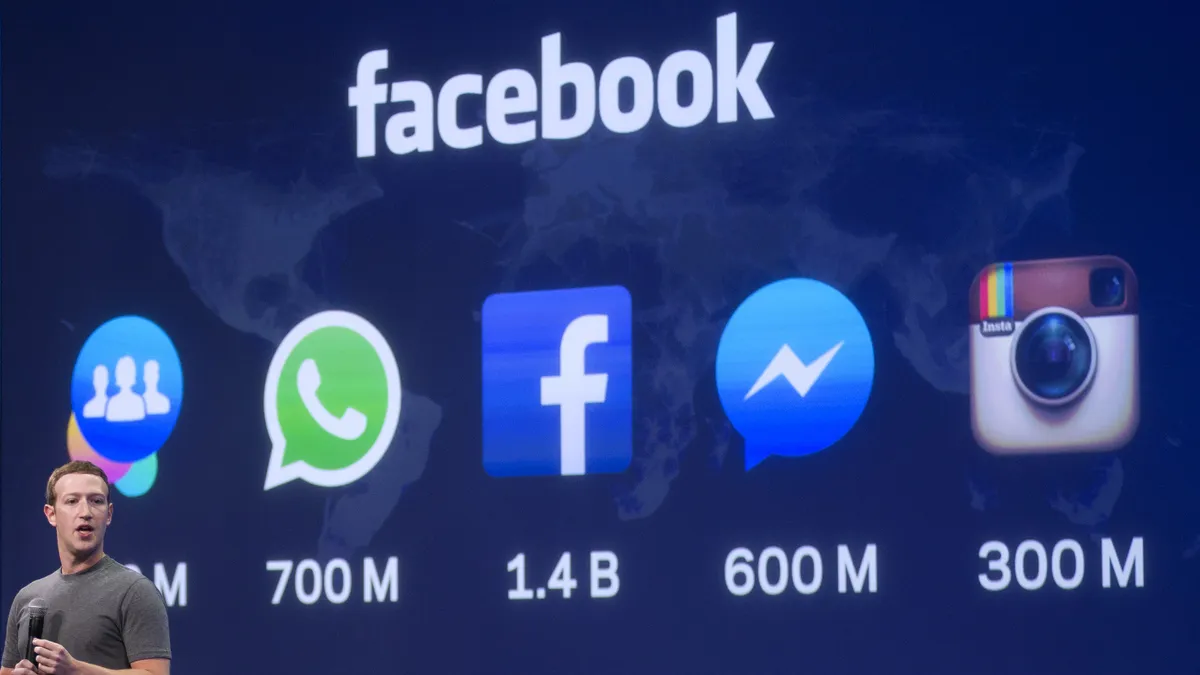Dive Brief:
- In its latest Diversity Report, published Tuesday, Facebook announced that over the next five years it plans to have at least half of its employees be from underrepresented backgrounds in STEM, including women, black, Hispanic, Native American and Pacific Islander individuals, people with disabilities, and military veterans. It would mean doubling the number of women employed by Facebook globally as well as the number of U.S. employees who are black and Hispanic by 2024, the company's chief diversity officer said.
- According to Facebook's 2018 EEOC filings, white men are the most common demographic for executive or senior officials and managers (45.5%), followed by white women (21.1%), and Asian men (14.9%). Nine of Facebook’s 1,053 executive and senior roles are held by black or African-American women, and nine are held by Hispanic or Latina women. For black and Hispanic men, the equivalent figures are 23 and 28, respectively.
- Though representation of minorities at the company rose across the board in the U.S. since 2014, Facebook said, technical roles lag behind the rest of the company. Seventy-seven percent of technical workers globally are male and in the U.S. 40% are white and 52.3% are Asian. Across all roles, the company is 63.1% male and its U.S. staff is 44.2% white, 43% Asian, 5.2% Hispanic and 3.8% black, per the report.
Dive Insight:
Despite its lucrative salaries and glistening campus, Facebook has seen scandals over reports of a toxic and "cult-like" workplace culture and its persistent lack of diversity. Earlier this year, a Facebook software engineer said she was harassed and sent transphobic messages for criticizing the company’s diversity record. In 2018, an ex-Facebook manager said that the lack of representation means black employees are overstretched and overworked, in being asked for their input on too many projects. Writing in a company-wide memo, he said that in some cases, employees' work on diversity initiatives "devolves into serving as an address book to add a few names of color to projects".
CNBC reported in January that Facebook uses a performance review system, "stack rank," which ranks employees biannually through a numerical metric. The service is controversial: Microsoft discontinued its use in 2013, and GE, Uber, and Amazon have all halted their use of the service, which is said to foster hypercompetition and reinforce implicit bias among senior managers.
Diversity statistics on Facebook’s technical side — employees with specialized knowledge in mathematics, engineering, or science — are indicative of talent pipeline and retention issues for minorities in STEM more broadly. In every state in the nation more men than women hold degrees in STEM subjects, and women and minorities experience higher rates of bias and discrimination in STEM fields, according to a recent Pew Research Center survey. Facebook is taking steps to boost representation in STEM early, such as with its $4.2 million investment in The Align Program which invites women and minorities to earn a master’s degree in computer science. Its 'Facebook University' program also targets underrepresented groups and integrates training in tech skills throughout an eight-week internship.
The tech giant’s inclusion initiatives include an internal leadership program for women, employee-led community summits for ethnic minorities and LGBTQ people, and training for managers on inclusive recruiting and decision-making. Experts previously told HR Dive that for a company to improve its diversity across the board, HR executives should focus on hiring minorities to management and recruiting roles, consider flexible working structures, and ensure the recruitment process is widely accessible.
Diversity must also go hand-in-hand with inclusion; if employees feel unsupported by leadership or don’t see proactive efforts to stop harassment or curb implicit bias, they’ll be more likely to leave an organization. A lack of diversity and an exclusionary culture can cause anxiety, and harm the progress of minority employees, studies have shown, and that can mean that a company is missing out on both ambitious talent and higher profitability.












